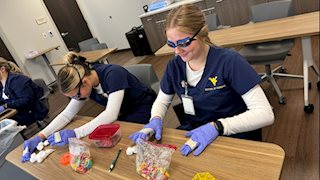MORGANTOWN, W.Va. – A team of West Virginia University scientists is working on a way to quickly detect agents that would cause infections, as a way to serve those brave men and women who serve in the U.S. armed forces.
Letha Sooter, Ph.D., assistant professor in the WVU School of Pharmacy Department of Pharmaceutical Sciences, is part of a team that is developing a simple testing apparatus that will offer rapid results for soldiers.
Much of Dr. Sooter’s research focuses on a bacterium called Pseudomonas aeruginosa, which commonly infects burn wounds. “It releases a toxin that causes a wound to die and inhibits the healing process,” Sooter said.
The bacterium has been associated with higher mortality in patients as well as increasing time and cost of care. Current diagnosis methods are reliable but take time to confirm an infection. During that delay, patients are often given antibiotics that can strengthen the antibiotic resistance of the bacteria.
The WVU team includes experts from the fields of chemistry, computer science and electrical engineering, and microbiology, immunology, and cell biology. They are working to identify binding elements for the bacterium, with the end goal of creating a highly sensitive device to detect the presence the bacterium in a wound.
“They take my binding element and incorporate it into their device, and all of a sudden, we’ve got a state-of-the-art sensor,” Sooter said. “Through WVU’s nanotechnology initiative, called NanoSAFE, that was possible. We’re really focused on getting all of these pieces together, so we can have this cool device.”
While the device will protect soldiers in the field, it will also be useful for detecting P. aeruginosa in civilians. In fact, the bacterium is responsible for 10 percent of all hospital-acquired infections, according to Sooter.
She admits developing a new device takes years of research and time, but she and the team feel their efforts are worth protecting service men and women.
 “Why develop these sensors? There’s a clear, present, unmet need – rapid, point-of-care diagnosis and detection of these agents,” Sooter said. “Say you have a person with a wound, they go to the doctor, the doctor swabs the wound, they have to grow it up in a culture, and a week later they can tell you what you’ve got. In the meantime, the person’s health has deteriorated. The person isn’t receiving the best possible treatment at the earliest possible time, which gives them a less positive health outcome. It’s an increased time of human suffering, increased dollars because that’s more doctor visits for them, and increased time that they have to take off work. All around, there is significant cost associated with delayed diagnosis and detection.”
“Why develop these sensors? There’s a clear, present, unmet need – rapid, point-of-care diagnosis and detection of these agents,” Sooter said. “Say you have a person with a wound, they go to the doctor, the doctor swabs the wound, they have to grow it up in a culture, and a week later they can tell you what you’ve got. In the meantime, the person’s health has deteriorated. The person isn’t receiving the best possible treatment at the earliest possible time, which gives them a less positive health outcome. It’s an increased time of human suffering, increased dollars because that’s more doctor visits for them, and increased time that they have to take off work. All around, there is significant cost associated with delayed diagnosis and detection.”
Other advantages of using Sooter’s testing method include small size, cheap synthesis, environmental stability, and long shelf life.
At the end of the day, serving those who serve motivates Sooter.
“The service members who are defending our country and putting themselves in harm’s way every day – I owe everything to them,” she said. “I’m very honored to try and help them and to give back to make their lives easier. In West Virginia, a lot of people are involved directly or have family and friends who are part of the service. I think it’s really important to make them as effective as possible, so they can be as safe as possible, so that they’re all healthy and can come home.”
This story appears in the latest edition of WVUhealth magazine, which can be found online at http://wvuhealthcare.com/media/wvu-health-magazine.
Photo captions: (Top photo) The WVU team working on an optical sensor that will detect causative agents of wound infections includes, from left, Slawomir Lukomski, Ph.D., Sc.D.; Jeremy Dawson, Ph.D.; Lisa Holland, Ph.D.; and Letha Sooter, Ph.D., who is holding the handheld sensor (pictured at bottom) that flashes a fluorescent signal when it recognizes toxins.


